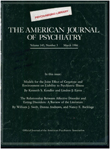Sexual violence in the United States and the role of season
Abstract
An analysis by the cosinor method of over 50,000 rapes in 16 different locations in the United States revealed statistically significant annual rhythms in 14 locations, with maxima in the summer. Changes in numbers of rapes and assaults showed similar seasonal patterns, suggesting that rape comprised a subcategory of aggressive behavior. In contrast, there was a virtual absence of seasonal changes in numbers of murders. A close relation emerged between assaults and rapes, on the one hand, and temperature, on the other, in different geographical locations. The authors hypothesize that human violence, just like aggression in nonhuman primates, is influenced by exteroceptive environmental factors.
Access content
To read the fulltext, please use one of the options below to sign in or purchase access.- Personal login
- Institutional Login
- Sign in via OpenAthens
- Register for access
-
Please login/register if you wish to pair your device and check access availability.
Not a subscriber?
PsychiatryOnline subscription options offer access to the DSM-5 library, books, journals, CME, and patient resources. This all-in-one virtual library provides psychiatrists and mental health professionals with key resources for diagnosis, treatment, research, and professional development.
Need more help? PsychiatryOnline Customer Service may be reached by emailing [email protected] or by calling 800-368-5777 (in the U.S.) or 703-907-7322 (outside the U.S.).



